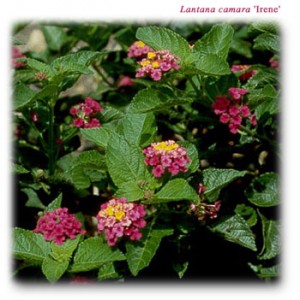August 18, 2007
Plant of the Week
by
David Rodriguez
 The lantana is a great landscape plant which is very adapted to this area provided they are grown in a sunny location. When established, the plants are very drought tolerant, and continue to produce bright and attractive blooms in the hottest of weather. Although a tender perennial, lantana is best used as a warm season annual, replanted each spring. Lantana is a great plant that butterflies and hummingbirds adore.
The lantana is a great landscape plant which is very adapted to this area provided they are grown in a sunny location. When established, the plants are very drought tolerant, and continue to produce bright and attractive blooms in the hottest of weather. Although a tender perennial, lantana is best used as a warm season annual, replanted each spring. Lantana is a great plant that butterflies and hummingbirds adore.
Some of the best varieties which are available from local nurseries are:
- New Gold — bright yellow, sterile flowers, spreading habit. This variety named New Gold blooms profusely but NEVER forms berries. The berries have to be removed before more blooms are produced. This revolutionary new development in lantanas insures that this plant will be a continuous beauty rather than a virulent pest with its unwelcomed seedling offspring. But you MUST insist on the New Gold variety; all other lantana varieties exhibit the characteristics which lead botanists to label them with the highly unfavorable specie name of horrida.
- Weeping Lavender — Fragrant, lavender, sterile flowers, low spreading habit.
Weeping White — Fragrant, white, sterile flowers, low spreading habit. - Pinkie — Pink/cream bicolor, sterile flowers on an extremely compact plant which never requires cutting back
Texas Flame (Dallas Red, New Red) — Orange/yellow/red tricolor blooms which turn to deep red, a compact bush. The reddest lantana available. - Samantha (Lemon Swirl) — Bright yellow, sterile blooms and beautiful variegated foliage on a compact bush. A beautiful plant even without blooms!
If you can’t grow this plant, I can’t help you! Simply trim it back two to three times after they bloom and feed with one-half cup of 19-5-9 analysis fertilization to encourage re-blooming.
Remember, Learn and Have Fun!
David Rodriguez is County Extension Agent-Horticulture, Bexar County. For more information, call the Master Gardener ‘Hotline’ at (210) 467-6575 or visit our County Extension website at http://bexar-tx.tamu.edu, click under Horticulture and Gardening.